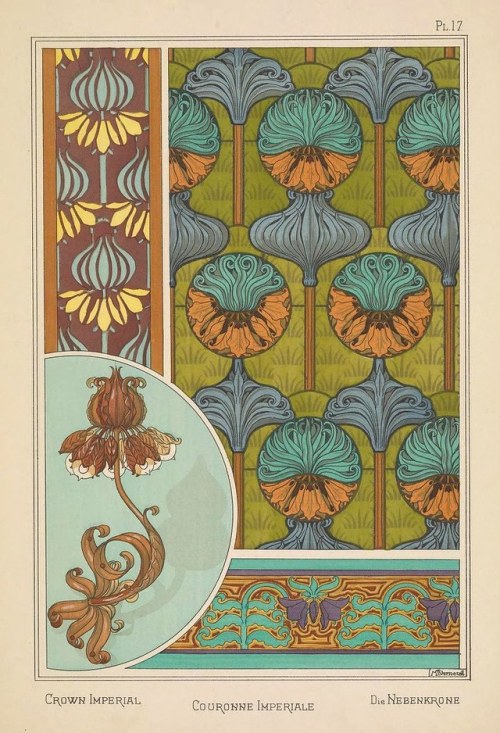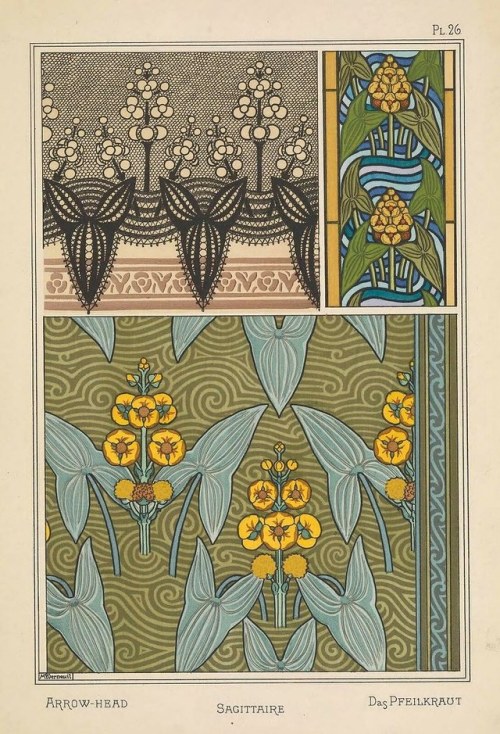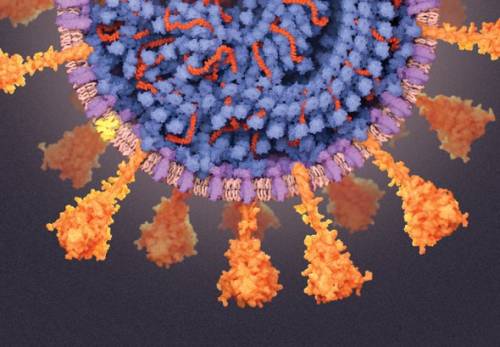Eugène Grasset, Plants And Their Application To Ornament, 1896





Eugène Grasset, Plants and Their Application to Ornament, 1896
Archive.org and Gallica.bnf.f
More Posts from Ritasakano and Others

Futon de algodão e um mimo para o neto!!

A Visual Guide to the SARS-CoV-2 Coronavirus
Illustrations by Veronica Falconieri Hays (Scientific American)
What scientists know about the inner workings of the pathogen that has infected the world
For all the mysteries that remain about the novel coronavirus and the COVID-19 disease it causes, scientists have generated an incredible amount of fine-grained knowledge in a surprisingly short time.
Thousands of different coronaviruses may inhabit the planet. Four of them are responsible for many of our common colds. Two others have already triggered alarming outbreaks of disease: in 2002 a coronavirus caused severe acute respiratory syndrome (SARS), which killed more than 770 people worldwide, and in 2012 a different strain started Middle East respiratory syndrome (MERS), taking more than 800 lives. SARS burned out within a year; MERS still lingers.
The newest coronavirus, SARS-CoV-2, has created a far deadlier pandemic in part because once it infects a person it can lie undetected for a long time. An individual who had the SARS coronavirus did not transmit it until 24 to 36 hours after displaying symptoms such as fever and dry cough; people feeling ill could be isolated before they made others sick. But people with COVID-19 can transmit the virus before they show clear symptoms. Not feeling ill, infected men and women work, commute, shop, eat out and attend parties, all the while exhaling coronavirus into the airspace of people around them. The virus can remain undetected inside the human body for so long partly because its genome produces proteins that delay our immune system from sounding an alarm. Meanwhile lung cells die as the virus secretly reproduces. When the immune system does hear the call, it can go into overdrive, suffocating the very cells it is trying to save.
In the graphics that follow, Scientific American presents detailed explanations, current as of mid-June, into how SARS-CoV-2 sneaks inside human cells, makes copies of itself and bursts out to infiltrate many more cells, widening infection. It shows how the immune system would normally attempt to neutralize virus particles and how CoV-2 can block that effort. It explain some of the virus’s surprising abilities, such as its capacity to proofread new virus copies as they are being made to prevent mutations that could destroy them. And it shows how drugs and vaccines might still be able to overcome the intruders.

Virus invasion and immune response
A SARS-CoV-2 particle enters a person’s nose or mouth and floats in the airway until it brushes against a lung cell that has an ACE2 receptor on the surface. The virus binds to that cell, slips inside and uses the cell’s machinery to help make copies of itself. They break out, leaving the cell for dead, and penetrate other cells. Infected cells send out alarms to the immune system to try to neutralize or destroy the pathogens, but the viruses can prevent or intercept the signals, buying time to replicate widely before a person shows symptoms.





Drug and vaccine intervention
Commercial and university labs are investigating well over 100 drugs to fight COVID-19, the disease the SARS-CoV-2 virus causes. Most drugs would not destroy the virus directly but would interfere with it enough to allow the body’s immune system to clear the infection. Antiviral drugs generally stop a virus from attaching to a lung cell, prevent a virus from reproducing if it does invade a cell, or dampen an overreaction by the immune system, which can cause severe symptoms in infected people. Vaccines prepare the immune system to quickly and effectively fight a future infection.


The remarkable and mysterious Coronavirus genome
The SARS-CoV-2 genome is a strand of RNA that is about 29,900 bases long—near the limit for RNA viruses. Influenza has about 13,500 bases, and the rhinoviruses that cause common colds have about 8,000. (A base is a pair of compounds that are the building blocks of RNA and DNA.) Because the genome is so large, many mutations could occur during replication that would cripple the virus, but SARS-CoV-2 can proofread and correct copies. This quality control is common in human cells and in DNA viruses but highly unusual in RNA viruses. The long genome also has accessory genes, not fully understood, some of which may help it fend off our immune system.

This article was originally published with the title “Inside the Coronavirus” in Scientific American 323, 1, 32-37 (July 2020). doi:10.1038/scientificamerican0720-32
Source: By Mark Fischetti, Veronica Falconieri Hays, Britt Glaunsinger, Jen Christiansen | Scientific American July 2020 Issue
Imagem Tempo Luz

Photographer Junku Nishimura








ART PRINTS BY FINLAY MCNEVIN
Potassium - Element Art
Helium - Element Art
Aluminum - Element Art
Calcium - Element Art
Fluorine - Element Art
Phosphorus - Element Art
Carbon - Element Art
Chlorine - Element Art
Also available as canvas prints and framed art prints
FREE WORLDWIDE SHIPPING + $5 OFF ALL PHONE CASES TODAY!
Peça lindamente bordada.

Outer kimono (uchikake), satin silk with appliqué and embroidery, 1870–90. Scenes from two well-known plays feature. The garment may have been worn by a Kabuki actor, but decorative themes on stage costumes were not usually so literal and may instead have belonged to a high-ranking courtesan. The enjoyments of the theatre and the brothel were closely linked during the Edo period (1615 – 1868), being at the heart of the ‘floating world’ of transient excitement and pleasure.

Women’s Activities
Artist: Ogata Gekko 尾形月耕 (1859-1920) Ink and color on silk Japan 1868-1912 Meiji era Freer Gallery of Art and Arthur M. Sackler Gallery

Meet the real women behind Hidden Figures.
Before electronic computers were common, NASA hired mathematicians like Katherine Johnson to do the computing. Even after NASA began using IBM computers to plan its missions, Astronaut John Glenn trusted Johnson’s abilities so much that he personally requested she recheck the computer calculations that helped him become the first American to orbit the Earth.
Johnson is one of the women whose work inspired the film Hidden Figures — the true story of three African American mathematicians who helped NASA launch the first Americans into space.
Feeling inspired? See how math might figure into your life. Uncover more about Katherine Johnson →
“Força eletrostática é aquela que governa o movimento dos átomos. É a força que os faz colidir e desenvolver a energia de sustentação da vida de calor e luz, e que os faz se agregar em uma variedade infinita de maneiras, de acordo com os designs fantasiosos da Natureza, e formar todas essas estruturas maravilhosas que vemos ao nosso redor . É, de fato, se nossas visões atuais forem verdadeiras, a força mais importante que devemos considerar na Natureza. ” Nikola Tesla
“Electrostatic force is that which governs the motion of the atoms. It is the force which causes them to collide and develop the life-sustaining energy of heat and light, and which causes them to aggregate in an infinite variety of ways, according to Nature’s fanciful designs, and forms all these wondrous structures we see around us. It is, in fact, if our present views be true, the most important force for us to consider in Nature.”
–Nikola Tesla
“Tesla, Marvel Of The Future.” Brooklyn Citizen, August 22, 1897.


Molecular body guards for neurons
In the brain, patterns of neural activity are perfectly balanced. The interplay between activating and inhibitory neurotransmitters ensures that the level of activity stays within the physiological range. During an epileptic attack excitation gains the upper hand resulting in the death of neurons. Researchers of the Bonn University Medical School have now discovered a key player in a signal transduction cascade, which protects neurons from hyperexcitation-induced cell death. These results open a new direction for the development of novel therapy options. The results are now published in “The Journal of Neuroscience“.
Pathophysiological activity often triggers neuronal cell death. This can for example be observed after an epileptic insult. The cause for this hyperexcitation is excessive release of the signaling molecule glutamate. “This neurotransmitter can switch on signaling cascades that act neurotoxic”, says Prof. Dr. Schoch McGovern of the Institute of Neuropathology and the Department of Epileptology at the University Clinic Bonn. However, neurons try to protect themselves and prevent the damaging hyperexcitation.
The molecular nature of these “body guards” is so far unresolved. Accumulating evidence shows transcription factors to play an essential role in the processes by which neurons protect themselves. These factors switch on certain genes, which then via signal transduction cascades result in the production of neuroprotective substances. These in turn counteract the damaging glutamate-induced hyperexcitability.
Increased neuronal cell death in the absence of Syt10
The team of Prof. Dr. Schoch McGovern could now show that the protein Synaptotagmin 10 (Syt10) is an integral part of this protective shield. If rats for example experience an epileptic seizure, the amount of Syt10 in the hippocampal formation of the brain strongly increases. The researchers used neurons from mice, in which the Syt10 gene had been ablated, and stimulated them with a glutamate like substance. This treatment resulted in substantial neuronal death.
NPAS4 modulates the production of protective factors
The research team discovered, which transcription factor activates the gene for Syt10 in response to pathophysiological neuronal activity. This essential member of the neuronal body guard is called NPAS4. The researchers cultured rodent neurons and added several transcription factors. NPAS4 activated the Syt10 gene and required Syt10 to exert its neuroprotective function. “NPAS4 triggers a signaling cascade that results in the production of neuroprotective factors”, says Prof. Dr. Schoch McGovern.
Search for novel therapy approaches
The molecular identity of the neuroprotective substances is still unknown. “A potential candidate, the insulin-like growth factor IGF-1, was not able to reverse the increased neuronal cell death in the absence of Syt10”, reports the neurobiologist. The next step therefore is to test other substances. Once the identity of the neuroprotective body guards is revealed, novel avenues for therapy development open up, for example for stroke and epilepsy patients. “The goal would be to administer these protective substances from the outside in order to prevent neuronal cell death in the brain”, says Prof. Dr. Albert Becker, a medical doctor, who was part of the study. However, there is still a long road ahead.
Muito ☺️ fofo!! Lindo trabalho.

Just a couple of sloths hanging out by CutieClicker
-
 mandragorawayne liked this · 1 year ago
mandragorawayne liked this · 1 year ago -
 jwalterweatherboy liked this · 1 year ago
jwalterweatherboy liked this · 1 year ago -
 fltmtn reblogged this · 1 year ago
fltmtn reblogged this · 1 year ago -
 grannysart liked this · 1 year ago
grannysart liked this · 1 year ago -
 palmbleu liked this · 2 years ago
palmbleu liked this · 2 years ago -
 globehalfdark2 liked this · 2 years ago
globehalfdark2 liked this · 2 years ago -
 yvesdivine liked this · 2 years ago
yvesdivine liked this · 2 years ago -
 grun-tu-molani liked this · 2 years ago
grun-tu-molani liked this · 2 years ago -
 vannervi liked this · 3 years ago
vannervi liked this · 3 years ago -
 itznymph liked this · 3 years ago
itznymph liked this · 3 years ago -
 ver-sacrum reblogged this · 3 years ago
ver-sacrum reblogged this · 3 years ago -
 ver-sacrum liked this · 3 years ago
ver-sacrum liked this · 3 years ago -
 bella-bella-bella-simamaer reblogged this · 3 years ago
bella-bella-bella-simamaer reblogged this · 3 years ago -
 nigromantero liked this · 3 years ago
nigromantero liked this · 3 years ago -
 hoyatzu liked this · 3 years ago
hoyatzu liked this · 3 years ago -
 laurino2 liked this · 4 years ago
laurino2 liked this · 4 years ago -
 faty1604 liked this · 4 years ago
faty1604 liked this · 4 years ago -
 chopinspre reblogged this · 4 years ago
chopinspre reblogged this · 4 years ago -
 shambolipatal liked this · 4 years ago
shambolipatal liked this · 4 years ago -
 islandinspace liked this · 4 years ago
islandinspace liked this · 4 years ago -
 sachsenritter liked this · 4 years ago
sachsenritter liked this · 4 years ago -
 maxernstman reblogged this · 4 years ago
maxernstman reblogged this · 4 years ago -
 foggywastelandcollectorus reblogged this · 4 years ago
foggywastelandcollectorus reblogged this · 4 years ago -
 maxernstman reblogged this · 4 years ago
maxernstman reblogged this · 4 years ago -
 allofthepretty reblogged this · 4 years ago
allofthepretty reblogged this · 4 years ago -
 angeline13 liked this · 4 years ago
angeline13 liked this · 4 years ago -
 pixelcurious liked this · 4 years ago
pixelcurious liked this · 4 years ago -
 bacteriocide reblogged this · 4 years ago
bacteriocide reblogged this · 4 years ago -
 bacteriocide liked this · 4 years ago
bacteriocide liked this · 4 years ago -
 owmyeyeballs reblogged this · 4 years ago
owmyeyeballs reblogged this · 4 years ago -
 owmyeyeballs liked this · 4 years ago
owmyeyeballs liked this · 4 years ago -
 kreativatanten reblogged this · 4 years ago
kreativatanten reblogged this · 4 years ago -
 wouldyoulikeacupofteadear reblogged this · 4 years ago
wouldyoulikeacupofteadear reblogged this · 4 years ago -
 wouldyoulikeacupofteadear liked this · 4 years ago
wouldyoulikeacupofteadear liked this · 4 years ago -
 actualmichelle reblogged this · 4 years ago
actualmichelle reblogged this · 4 years ago -
 actualmichelle liked this · 4 years ago
actualmichelle liked this · 4 years ago -
 servilius reblogged this · 4 years ago
servilius reblogged this · 4 years ago -
 prayingmanits reblogged this · 4 years ago
prayingmanits reblogged this · 4 years ago -
 sunnyboy94 reblogged this · 4 years ago
sunnyboy94 reblogged this · 4 years ago -
 curtisjensen reblogged this · 4 years ago
curtisjensen reblogged this · 4 years ago -
 lonciera reblogged this · 4 years ago
lonciera reblogged this · 4 years ago -
 lonciera liked this · 4 years ago
lonciera liked this · 4 years ago -
 rat-in-a-sock liked this · 4 years ago
rat-in-a-sock liked this · 4 years ago